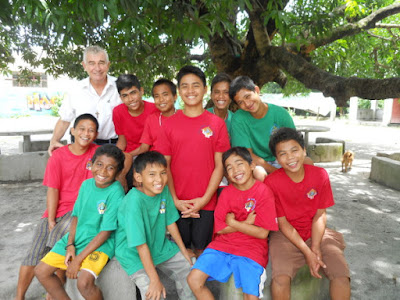Columban Sister Kathleen Melia: ‘Just one more on someone’s hit list’

Sr Kathleen Melia SSC [Sunday Examiner]
Columban Sister Kathleen Melia SSC, from County Leitrim, Ireland, was attacked outside her home in Midsalip, Zamboanga del Sur, Philippines, on the evening of Ash Wednesday. She is now recovering in Manila. Below is an article from the 19 March 2017 issue of Sunday Examiner, the English-language weekly of the Catholic Diocese of Hong Kong. It is slightly edited and used with permission.
OZAMIZ CITY (SE): ‘The wound in the people’s minds is deeper and more painful than the wounds in the body of Sister Kathleen Melia,’ Columban Father Sean Martin from Ozamiz City in the Philippines told the Sunday Examiner after the 70-year-old Columban Sister was bashed in her home on 1 March, Ash Wednesday.
Sister Kathleen has worked among the Subanen people in the hills of Zamboanga for over 30 years and the unexplained attack is being described by the people as one more step in the chain of evil that is maligning their lives.
Sister Kathleen returned home to Midsalip on the afternoon of 1 March. Around 9.30pm she went out to close windows when she was attacked.
A hand was clamped over her mouth and the other hand began choking her, but she was able to get at her attacker’s face and, in protecting himself, he took his hand off her mouth—she screamed. He then thumped her on the chest and she fell the 30 centimetres from the raised pathway, hurting her leg and losing consciousness. He then ran off.
Sister Kathleen lives in a compound of three houses, the other two are community homes for the Subanen people to gather and speak in their own language without being mocked, derided or laughed at by others. After 30 odd years she speaks their language well and the people came to help her, then the police arrived. As people wondered whether the attacker intended to kill or frighten her, the police sent security with her to a hospital in Ozamiz City.

Midsalip
Sister Kathleen needed a blood transfusion, but the search for a donor was arduous and time consuming, with a seminarian eventually having to travel the five hours from Cagayan de Oro to match her B negative blood type. (Fewer than one percent of Filipinos have RH negative blood).
Then a boat trip to Manila, as flying was problematic. The morning boat had not arrived by nightfall, but there was faith it would come eventually.

Fr Sean Martin
Father Martin, who spent many years in Midsalip, says that this is just one act of violence among many in the volatile area of the nation, where the politics of the gun reign, the rich plunder and grow richer and the poor are squeezed out of even the little they have. But this is how politics and industry operate in Mindanao and deaths related to conflict of interest among various groups does not come as a surprise.
Father Martin related that in the previous week, Rosing Arnosa, who ran in the election last May against the incumbent mayor, Leonida Angcap, was shot five times in front of his house in Midsalip around nightfall. Although badly wounded he did not lose consciousness and recognised the gunman, who is now the murderer, as Arnosa later died of his wounds in a hospital in Pagadian City around 1.00am. He believed that the barangay captain, Eduardo Selim, from Matalang, was angry because his son was arrested and charged with being a goon (violent enforcer) for Angcap. Bail was set at Php120,000 (US$2,400, €2,200).

Picketing area in Midsalip
In the small town of Midsalip alone nine people were killed in the run up to the elections in May last year. Four were goons, thugs or hitmen of another mayor and five worked for Conrado Lumacad, who also ran against Angcap.
Father Martin adds that although the mayor has two charges of plunder against her, it does not seem to concern her, even though President Rodrigo Duterte has used some rhetoric about the crime. He seems more intent on killing the poor and did not complain when the congress removed the charge of plunder from the ‘Kill Bill’ that was passed in the lower house on 7 March.
‘But in these remote areas, killing witnesses and scaring opponents is the usual way for powerful people to keep control,’ Father Martin explained. He also remembered that Angcap’s son killed five road workers while driving under the influence in the early hours of the morning in 2013, but it was hushed up and did not even make it to the newspapers. He still holds his job with the municipality.
‘Plunder, manslaughter with impunity is the name of the game in the world of the mayor and it just increases the brazenness,’ Father Martin reflected.
It is all a warning to Sister Kathleen not to stand in the way of mining and logging companies that come to rape the countryside, mostly illegally. She is just one more person on someone’s hit list.
Columban Father Vincent Busch, of Subanen Crafts and seen at the beginning of the video above, recently sent an update on Sister Kathleen’s situation. Here is the last part of his report.
On 14 March Sister Kathleen’s operation began at 11am as scheduled. The surgical team was led by Osteopathologist Doctor Vicente Gomez. For two hours Dr Gomez tried to take out the old pin that was inserted in her leg during a previous surgery years ago. That pin is now obsolete and the instruments used to extract it were no longer readily available. The doctor knew that the previous pin was old so he asked the manufacturer of the pin for the proper instruments to remove it. Even with the proper tools the doctor couldn’t remove the old pin.
He tried alternative instruments but these instruments also did not work. What he had planned to do was take out the old pin and replace it with a new and longer one. In the end, he inserted the new pin next to the old one. The old pin had adhered to the bone. Ordinarily it would have taken only 1 1/2 hours to fix the fracture; instead the surgical procedures lasted from 11am to 6pm. Sister Kathleen will not be able to put weight on her repaired leg for three months. She will need to use a walker until the leg and bone have healed and strengthened.
Through all these past three weeks Sister Kathleen has been aware of her situation. She was and remains calmly involved in her recovery. While in
Ozamiz she had many Subanen visitors who have known and worked with her for decades, as well as visitors she knows from Ozamiz. I visited her every day and on Sunday 5 March 5 celebrated Mass with her in the hospital, with the Columban Sisters of the Ozamiz City community present.
On the morning of 15 March Sister Kathleen had her first therapy session in which she managed to sit on the side of her hospital bed.
This chronology presents the events following the attack on Sister Kathleen. It reveals her calm resolve in facing her ordeal, and it brings to light the efforts of the Subanen Ministry and of Columbans, especially the Columban Sisters, to tend to Kathleen’s needs.

Sister Kathleen with friends in Midsalip
Misyon, now MISYONonline.com, the magazine of the Columbans in the Philippines of which I have been editor since October 2002, published an article by Sr Kathleen Melia in the May-June 1998 issue, Mining: Threat to our Tribes.
In an article by Mary Joy Rile, editorial assistant of MISYONonline.com, in the November-December 2011 issue, Hope for Midsalip, Sister Kathleen is quoted: If a Subanen cuts down one tree, he is charged for breaking the law. But what about the loggers who move freely? The Subanens have been oppressed in their own land. When mining is permitted, the companies will claim the land, the water, the trees and the rest. There is no justice here in Midsalip.

Rice land, Midsalip
God said, ‘See, I have given you every plant yielding seed that is upon the face of all the earth, and every tree with seed in its fruit; you shall have them for food. And to every beast of the earth, and to every bird of the air, and to everything that creeps on the earth, everything that has the breath of life, I have given every green plant for food.’ And it was so. God saw everything that he had made, and indeed, it was very good (Genesis 1:29-31).

Proposed drilling site, Midsalip







 Frs Owen McPolin, John Blowick and Edward Galvin
Frs Owen McPolin, John Blowick and Edward Galvin 


















